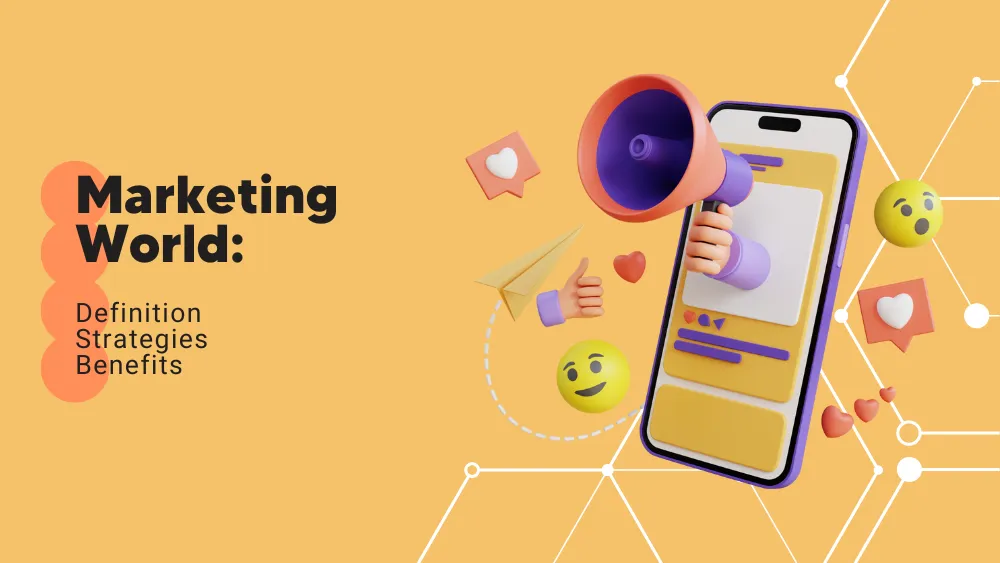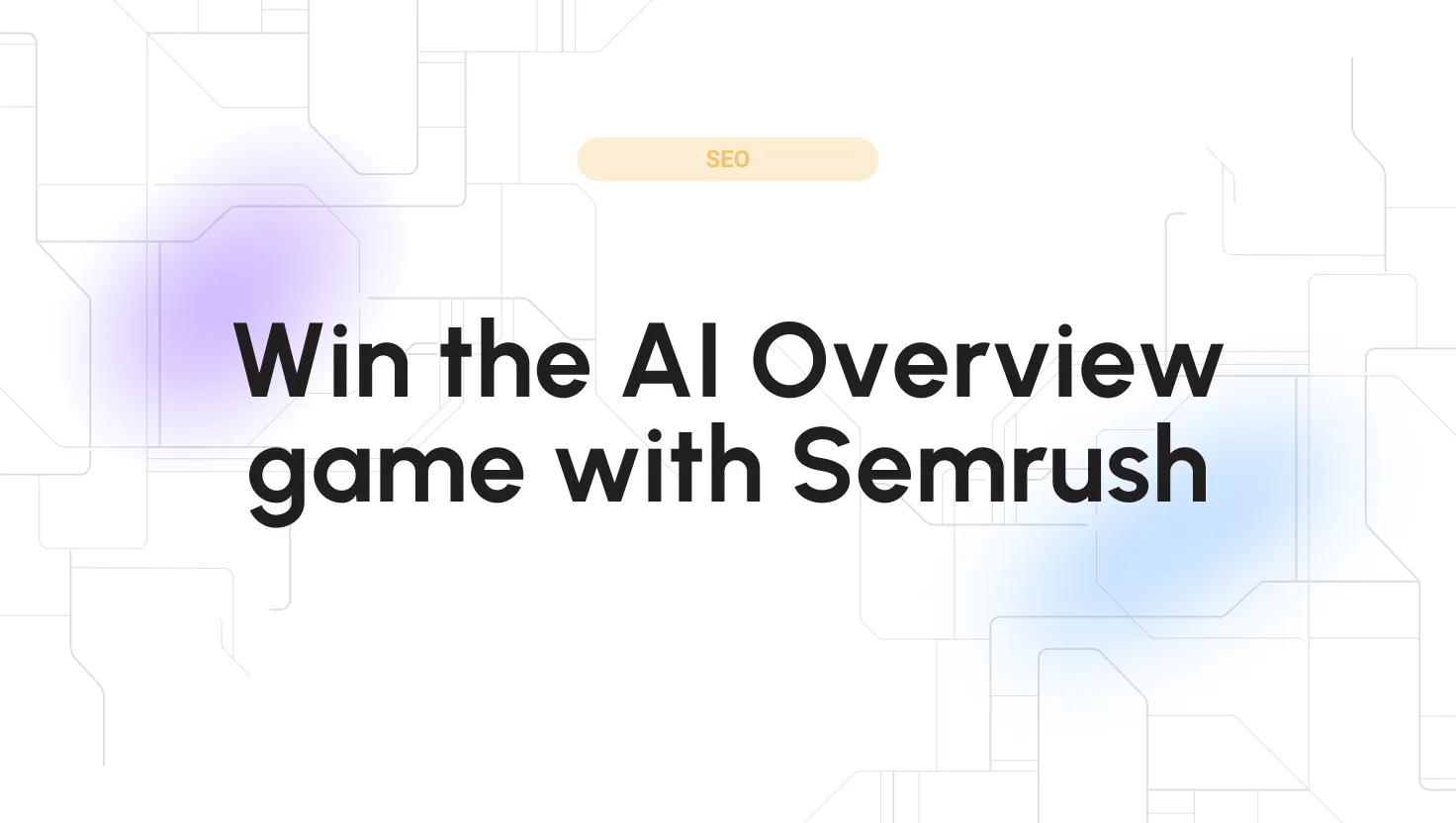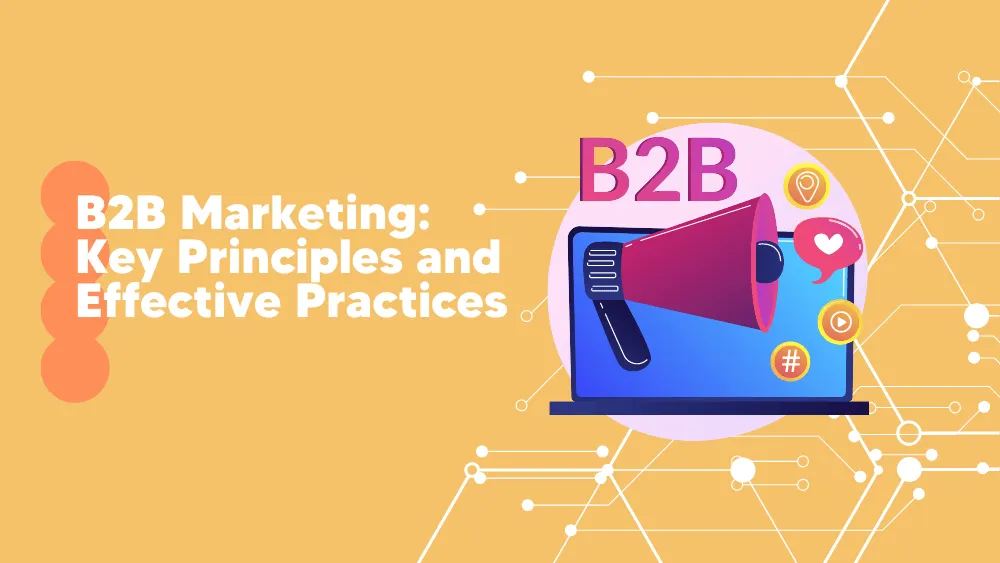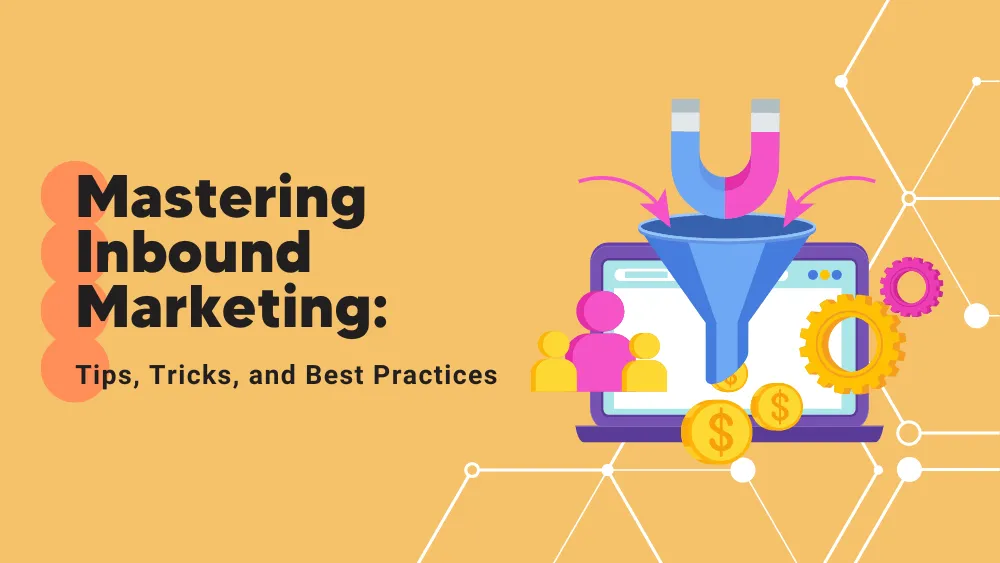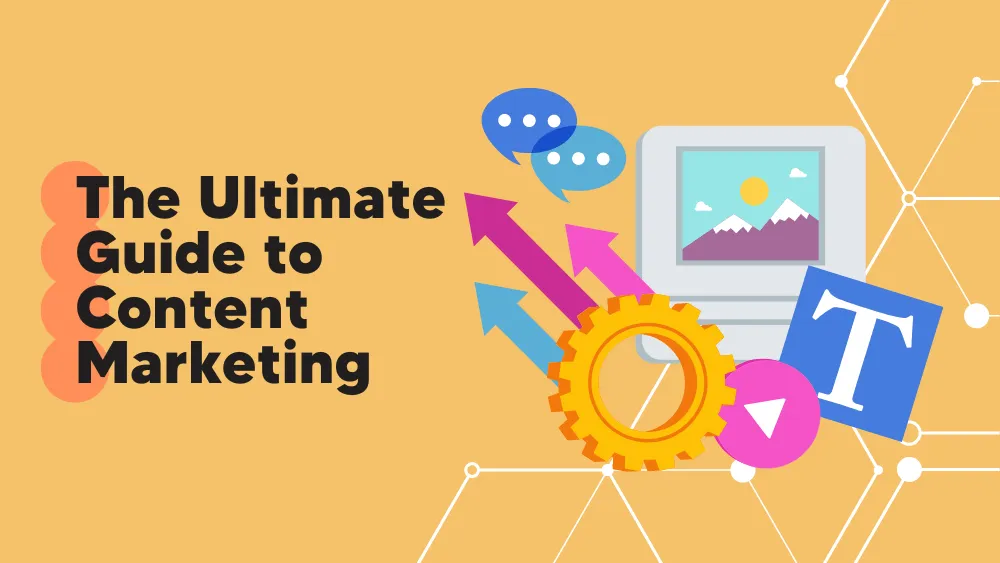Have you wondered how the marketing concept appeared? The answer to this question is foreseeable; Marketing appeared because of every human need and demand. All goods, services, or products are made to fulfill all human needs. Moreover, how marketing works can be represented by a simple cycle:
To understand better the image below, let me give you an example of this cycle; everything starts with the customer that has a need. He wants to eat, but the insufficient amount of time that he has makes it a problem; in this case, the product is the food that organizations or businesses make based on customer demands. They create unique ways to satisfy consumer needs.
Options may differ based on customer needs; therefore, more providers have the same idea but a different approach. We settled together on what marketing refers to, but more is needed. Let’s go deeper into this article to learn more about marketing, especially for SaaS Businesses. If you are ready, please wear your seatbelt and let me lead you into the marketing world.
What is Marketing?
A wooden boat can only dive with a paddle. As a result, we already know how marketing appears, but we need a definition to use it. So American Marketing Association defines it as “the activity, set of institutions, and processes for creating, communicating, delivering, and exchanging offerings that have value for customers, clients, partners, and society.” (Approved in 2017)
My definition of marketing is this: Marketing is the philosophy of creating profitable customer relationships by meeting their expectations uniquely and efficiently. According to Our World in Data, around four billion people have been using the Internet since 2020, and it keeps growing till the present. These statistics show that it has become increasingly crucial for businesses to incorporate digital marketing strategies into their overall marketing plans because more and more people are using the Internet, which represents a possible way to reach the audience.
To sum up, digital marketing uses digital or social channels for advertising a brand, a product, or a service to reach consumers through different formats like online videos, digital ads, paid social ads, and social media posts.
Marketing Mix
Marketing is not only about advertising; it is covered by 4P, which represents the marketing mix that expresses product, price, place, and promotion – as critical elements in developing marketing plans and strategies to engage their target market effectively. Usually, companies consider the 4P when assembling marketing strategies to catch their target audience. This essential and most common marketing mix was introduced in 1960 by E. Jerome McCarthy that includes:
- Product – This represents the product created to meet consumers’ expectations or a service that solves a customer’s problem. Usually, startups fail in this marketing stage because they develop what they want rather than a solution for consumers.
- Price – By considering the costs, competitor pricing, and target market demand is created the amount of money a consumer spend for the product or service. This P will put bread on your table, so make sure it is a thought-out segment.
- Place – Is made by the channels and areas businesses utilize to make their products or services available to clients. The optimal place to sell goods is selected based on distribution canals, retail locations, and online platforms.
- Promotion – is the promotional kit of activities that promote products or services to the target market. Promotion activities may include advertising, sales promotions, public relations, and personal selling.
This marketing mix can lead to a marketing plan with well-planned strategies that covers all the essential elements necessary to seduce and keep customers, distinguish yourself from rivals, and achieve success in the marketplace.
Marketing Mix for SaaS Businesses
SaaS delivering business model is a part of services marketing. Services marketing is a subfield of marketing that focuses on promoting and selling intangible products or services rather than physical products. As a result, SaaS Marketing makes part of B2B software marketing that promotes subscribed-based SaaS products to businesses.
Nowadays, SaaS companies provide an intangible commodity, unlike the traditional way of installing the software on-premise. It must constantly prove to its existing clients that subscription service is worth the monthly charge. Consequently, marketers should consider the 7Ps of services marketing to create a strategic plan for SaaS Businesses, so let’s look at the framework of service marketing made by:
- Product – the product of SaaS Businesses is web-based software hosted and delivered over the Internet as a service to customers. Solving the problem of accessibility for software makes it a valuable product.
- Price – pricing system for SaaS products is usually based on a subscription fee valid for a month or year.
- Place – delivering the software via the Internet results that this P refers to the channels through which the software is accessed and delivered to customers.
- Promotion – If the product is not physical and can be used only with an internet connection, the best way to promote it is also on the Internet. Hence, creating digital marketing strategies is guaranteed the best option for promoting SaaS products.
- People – All businesses are based on people, starting with simple employees and ending with the company’s CEO. People define the core of a company’s results, and that’s why I agree with this statement; “I think as a company if you can get those two things right – having a clear direction on what you are trying to do and bringing in great people who can execute on the stuff – then you can do pretty well.” – Mark Zuckerberg, CEO of Facebook.
- Process – This P responds to the delivery process that adjusts to the customer’s relationship with the business. That’s why companies are trying to evolve the process of delivering consistently. Despite the online products that SaaS companies provide via the Internet, clients select the SaaS delivering system for sharing software quickly and efficiently.
- Physical evidence – The physical evidence in a SaaS business refers to any tangible elements that customers can associate with the brand or product, such as marketing materials or branded merchandise. Some of this evidence could be events, and well-branded merchandise at this event could be personalized t-shirts, hoodies, coffee cups, and others.
Marketing Funnel
This funnel represents a model describing the stages a potential customer goes from awareness-business to purchasing. The marketing funnel works like a car engine, so all funnel segments must work perfectly for the journey to success.
- Awareness: Represents the percentage of possible consumers who remember the company and people who are introduced to the brand, built throughout advertising campaigns.
- Consideration: Brand consideration is to find the percentage of customers considering a brand for possible purchase options.
- Purchase: The purchase stage is to find the percentage of customers who purchase from the brand; even if the company gets the sale, the journey is not over.
- Loyalty: It represents the process of a strong relationship with clients, which aims to repeat the customer journey.
- Advocacy: Receptive individuals in your loyalty program support your future marketing funnels, and good examples are the Twitch streamers which advertise some gaming setup from a provider.
Marketing vs. Sales
Sales and marketing are brothers linked to work upon the revenue for the organization. Moreover, marketing focuses on long-term goals; as a result, sales have a short-term outlook. Sales divisions run on fast periodic targets, while marketing workflow has a characteristic of a long period of time. Marketing campaigns may not have an immediate visible impact on a company’s revenue, but they still help the company grow over a longer period of time. In a few words, marketing emphasizes brand awareness and lures for business, and sales transform the leads into buyers.
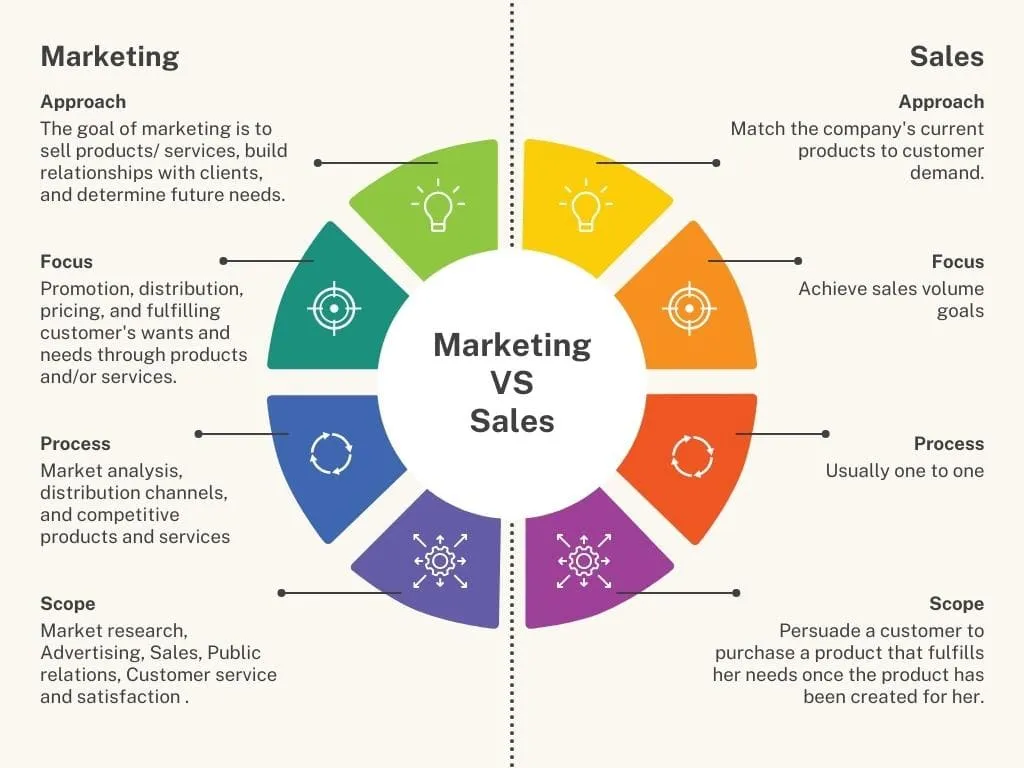
Types of marketing
Businesses use different types of marketing to promote the company for driving sales and not only; therefore, to be a step ahead of competitors’ different types of marketing represents a way to reach your target audience and get more sales. From inbound marketing (which takes care of all types of content that a business can deliver to their customers) to outdoor strategies that take your product outside the digital world. But these are the most popular ones where businesses make a presence:
-
Digital Marketing
Also known as Online Marketing, Digital Marketing represents the online path of advertising content across digital media channels like websites, landing pages, and social media. It also makes a presence in paid digital channels, including search engines ( Google, Yahoo, Bing ), SEM, pay-per-click (PPC), content syndication, social media, email, text, and more.
-
Content Marketing
This strategy (part of social media marketing ) highlights creating and sharing relevant types of content such as images, videos, podcasts, social media posts, and blogs for customers. Creating content based on customers’ preference makes them happy that their opinion matters to the company.
-
Social Media Marketing
This is the preventive promotion actions of a brand, product, or service thru social media channels like Facebook, Instagram, Twitter, Tiktok, and LinkedIn. As a result, social media platforms offer marketers evolved ads manager where they can interact with a unique customer segmentation selected by age, gender, studies, preferences, and others for their marketing campaign.
-
Email Marketing
When electronic mail became famous in 1978, the father of spam, Gary Thuerk, marketing manager at Digital Equipment Company, sent the first email marketing to promote his company’s products. So the way of promoting stuff with the aid of emails is called email marketing, which resulted in $13 million in sales for Gary.
-
Influencer Marketing
Another good way of promoting goods is selecting an influencer from the same domain as your business. Despite the low level of trust that companies usually have, calling an influencer for an advertisement to recommend company products can enhance trust and customer relationships.
-
Affiliate Marketing
The method where the publisher ( affiliate ) gains an errand by advertising a product or service made by another merchant using an affiliate link. As a result, the affiliate partner is paid for delivering the sale to the retailer or advertiser.
-
Event Marketing
Represents a way of promoting that can take many forms, like a conference, trade show, product launch, festival, etc. Typically, interacting face-to-face with potential clients during event marketing can lead your business to more leads and build brand awareness.
-
Traditional Marketing
This is the opposite of digital marketing because this is the offline promotion method for targeted audiences off the internet. It evolves to advertise on radio, newspapers, magazines, billboards, TV advertisements, cold calling, telemarketing, trade shows, and sponsorships.
-
Guerrilla Marketing
When everything is severe in the business world, Guerilla marketing relies on creativity, humor, and surprise to grab the audience’s attention and generate excitement using low-cost and unconventional tactics. It can be a funny viral video, unique graffiti, flash mobs, etc.
-
Direct Marketing
Starting from the word direct, we already understand that this strategy represents the direct way of communication and distribution to consumers, which can happen during the distribution system like messaging,door-to-door-visits, sms, social media, mails, or emails. When customers respond to the direct marketing campaign, they get the essential part, a call to action such as clicking on a link, how usually beer has. Use the promo code on the official site of the beer’s provider, and customers can win a trip or even a car.
Understanding your target audience
Any successful marketing strategy is based on the target audience; as a result, marketers must understand their perfect consumers to create the promotion based on their preferences and characteristics. Let’s take a look at what the target audience really means.
What is Target Audience?
Target Audience is the segment of persons defined by specific demographics and behavior who can become consumers buying a product or a service. By understanding the target audience’s needs, interests, and preferences, businesses can create marketing messages more likely to meet their expectations and drive them toward their purchasing journey.
Market Segmentation
Market segmentation is a marketing process that divides prospective buyers into classes or segments with different expectations but responds similarly to the product or service. Moreover, market segmentation facilitates businesses to aim for different types of consumers who notice the fundamental importance of certain products and services from the same market. An example of market segmentation is that restaurants or fast food do; they segment their market based on how hungry customers are, creating small, medium, and large menus based on consumers’ preferences.
Identifying your target audience
Now that we know what Target Audience and Market Segmentation are, we can start to identify the target audience for a business through an example. Responding to the central question of a company, what are they solving? So everyone knows Mcdonald’s, the American multinational fast-food chain. Why they became so popular? Because they fulfill the primary mission they are based on, creating food in a fast way.
Wasting time preparing food, expensive product, insufficient skill in the kitchen, and so on are just some problems that Mcdonald’s solve. But where they found these problems? The answer is worth millions; they saw these problems based on their targeted audience. McDonald’s primarily targets young adults and families with children with the abovementioned problems.
Creating buyer persona
The buyer persona is an imaginary representation of your ideal customer based on data and research about the target market’s characteristics, behaviors, goals, and challenges. Marketers create this persona to understand better the target audience for better marketing campaigns. By the image attached above, we can see the template of the buyer persona; with the help of this example template, specialists will be able to attract possible clients, leads, and buyers during their campaign targeted to an audience based on buyer persona.
Developing a Marketing Plan
We already get to the action; knowing about the target audience, types of marketing, and what marketing is about, we can develop a well-planned plan. To get started, let’s step into the guide to creating the plan:
-
Setting goals and objectives
Settle clear vision and goals for the beginning of developing a marketing plan. Goals must be measurable, specific, and, most important, achievable. An example of an intent to a marketing plan would be like this: Getting an increase of sales by 32% within the following year. As a result, this goal can be measurable by analyzing the company’s progress in 1-4Q of the year.
-
Conducting a SWOT analysis
SWOT analysis is a strategic tool marketers use to evaluate a business or organization’s current situation and the environment of their marketing moves. By conducting a SWOT analysis, specialist marketers gain finer wisdom on the internal and external elements that may influence their strategy. Moreover, SWOT covers the Strengths and weaknesses, which are internal factors, such as the company’s products, services, personnel, and resources. Opportunities and threats are external factors, such as industry trends, competition, and economic conditions.
-
Developing a marketing strategy
After we get a clear vision and goal of which the business stands for and analyze the internal and external factors, we can use the marketing mix where the company is identified for the marketing strategy. As a result, with this information, marketers can create a comprehensive strategy highlighting how the business will reach its target audience and achieve its marketing objectives. This strategy should include a unique value proposition, specific marketing goals, and a tailored marketing mix that utilizes the most effective tactics and channels to reach the target audience.
-
Creating a budget
Before developing a marketing strategy, your budget responds to the level of the strategy you afford. Therefore, the general rule of thumb is to allocate 5-10% of the company’s revenue to the department. Once you have determined your overall budget, identify the marketing tactics and channels to build the marketing plan.
-
Measuring and analyzing results
This point of the guide relates to all other steps from above. Measuring your company’s goals, SWOT analysis, and budget will give remarkable results for future marketing plans. Monitoring the process can lead to a new business strategy optimization and fewer expenses by identifying what works and doesn’t in the plan.
Conclusion
Marketing is about people and research and how it increases a provider’s revenue that solves the problems of the targeted audience. Four billion people have been using the internet since 2020, and it keeps growing to the present. This means that it has become increasingly crucial for businesses to incorporate digital marketing strategies into their overall marketing plans because more and more people are using the internet, representing a possible way to reach the audience.
Before creating a plan, marketers research all the information possible to create the marketing mix to ensure that the strategy used will be efficient. This research helps them comprehensively understand their customer’s needs and preferences and the broader market landscape.
In the future, marketing will become more powerful thanks to MarTech, which is evolving yearly. Using new technologies to gather customer information will become easier and more accurate because of AI and ML. I recommend learning the theoretical part of marketing, even the smallest detail. Different strategies will ensure your place in the industry and keep your placement ahead of your competitors.

